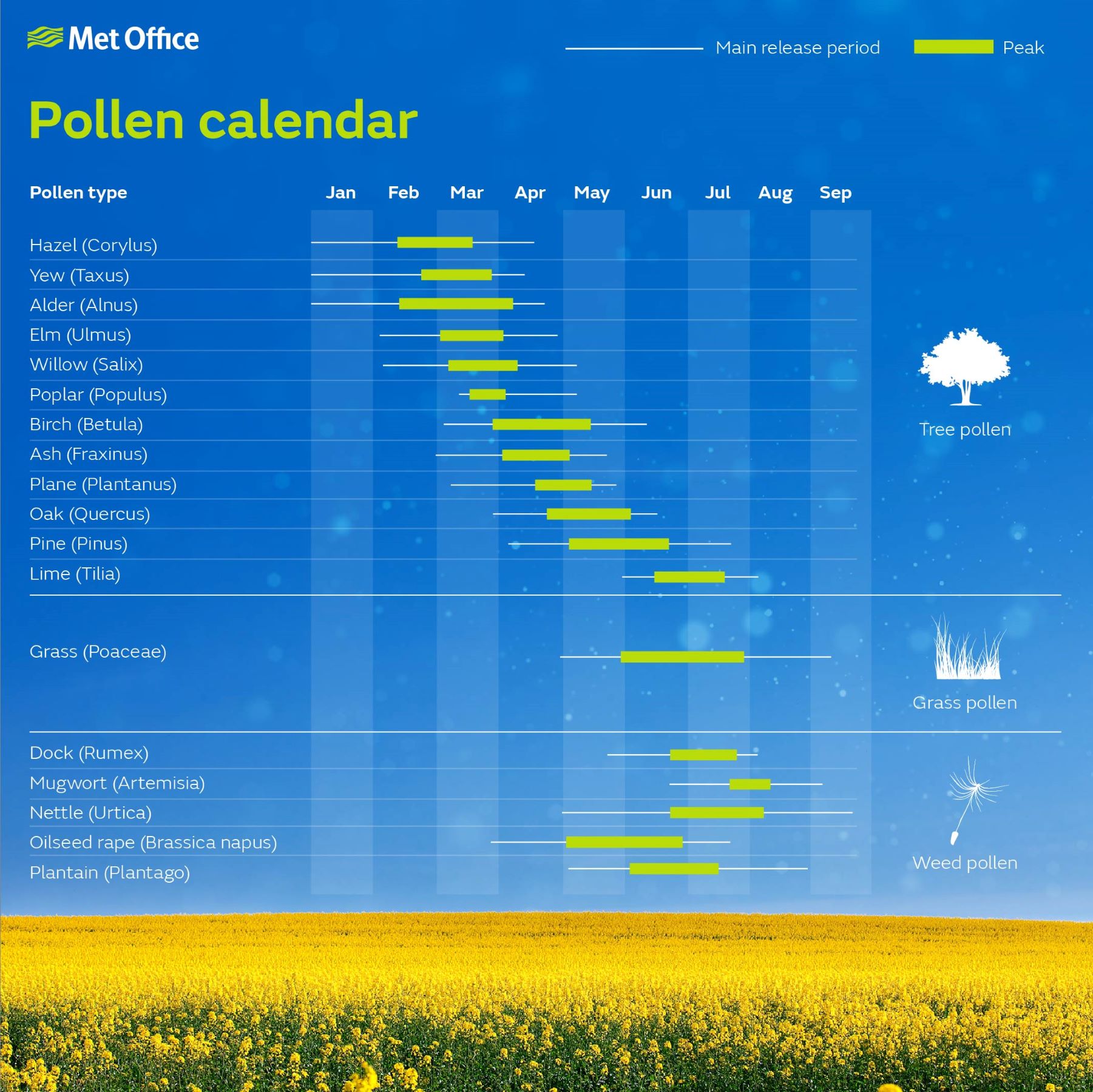Spring weather for many people means some warmer weather, April showers and seeing wildlife awaken from a winter slumber. However, for the one-in-five that suffer from hay fever, it can be the start of months of sneezing, watering eyes and keeping a keen eye on the pollen forecast.
After the wettest March in over 40 years for England and Wales, some are now wondering what the weather we’ve seen so far could mean for the release of pollen this year, with ‘very high’ forecasts for tree pollen already for some areas of the UK.
What’s the pollen outlook?
The majority of hay fever sufferers are allergic to grass pollen, which can start as early as May and generally peaks in June and July. At present, the focus is on tree pollen, which a minority of people are allergic to, but can still cause some potent hay fever symptoms for those with the allergy.
Yolanda Clewlow is the Met Office’s Relationships Manager for Health & Air Quality, and the UK Pollen Forecast Manager. Speaking to the Weather Snap podcast, she said: “We’re constantly monitoring what’s in the atmosphere and what might be coming, in terms of pollen in the air.
“We look at a very broad picture for the pollen outlook, including the weather in the previous year when pollen is formed on some plants to make a judgement on how bad a season might be for pollen release.”
At the time of writing, birch pollen is predominantly in focus, with very high levels expected, particularly in England and Wales.
Yolanda added: “Tree pollen is the main factor in the forecast at the moment, and this week, with more settled conditions, we’re expecting a large amount of birch pollen in the air, but these different types of tree pollen in the air will shift as we head towards summer.”
The changing types of pollen
The pollen season is broadly split into three phases, with trees generally the first to release pollen, then grass, followed by weeds.
“The pollen seasons aren’t distinct and there’s obviously a lot of overlap with different types in the air,” said Yolanda.
“It’s not possible to forecast for the whole pollen season at this range, but we’re expecting a large amount of tree pollen in the air in the coming weeks, then we’ll be continuing to keep a close eye on the grass pollen generation and release in the coming months.”
In general, pollen production can be more significant in a warm and wet spring and early summer. This would then need to be released in breezy and dry conditions to create the most significant impacts.

How to manage hay fever
Although many have no adverse reaction to pollen in the air, for those who do suffer with hay fever, there are some steps that can be taken to minimise the impact.
According to Yolanda, the best defence is avoiding the allergen as much as possible in the first place.
“The first thing to do is to make sure you understand the type of pollen you’re allergic to and monitoring the forecast. That way, you know when the very high days of pollen are coming and you can take precautions to try and avoid the pollen. However, it’s not possible to avoid it altogether so for some it’s about taking that preventative medication and planning your day to try and avoid being out in the pollen at the peak times.”
Pollen levels generally peak at the start and the end of the day. During a warm day, pollen gets carried higher in the atmosphere and often goes beyond the range a human would breathe it in. This means the middle of the day can often have fewer pollen grains in the air.
As temperatures cool down in the evening, these levels can pick up again as pollen drifts back towards the level of atmosphere that we breathe in.
“It’s also important to think about what things you have in the atmosphere when those pollen levels are at their peak during the day. Think about whether you want your washing outside, or anything that can be outside picking up pollen and bringing it inside, whether that’s your hair, your washing or your pets.”
Pets can also be affected by hay fever, and in severe cases vets can often prescribe medication to help furry friends through the summer.
Find more advice on dealing with hay fever as part of WeatherReady with the Met Office.
Pollen and climate change
With global temperatures increasing as a result of human-induced climate change, the pollen season in the UK isn’t immune to the effects of a changing climate.
Climate models suggest an increasing likelihood of warmer, wetter winters and hotter drier summers, which will influence the release of pollen into the atmosphere.
Yolanda added: “We’re already seeing an impact on the pollen season as a result of climate change. Some species are having longer seasons, some are starting earlier and some are more severe. We’re also looking at invading species as we anticipate that more species from outside the UK will begin to be able to take hold here and release pollen.”
Get pollen alerts directly to your phone on the Met Office app, or visit the pollen forecast on the Met Office website.
Yolanda was speaking to the Met Office’s Weather Snap podcast, available from 21 April wherever you get your podcasts.


